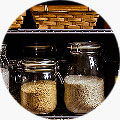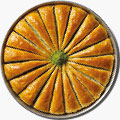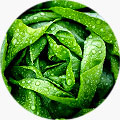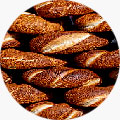Fresh Oven baked Rice Pudding - Firin Sutlac
1 Portion
Fresh, handmade everyday
Shipping on the day of Baking.
Milk based traditional rice pudding
Since we have internalized and taken for granted many flavors in our cuisine, we do not dwell on them much, and accordingly, we do not know what that flavor is and what it contains in its past. It would not be wrong to say that one of our exemplary flavors is rice pudding. Let's take a closer look at what rice pudding is, by looking for answers to questions such as what is rice pudding, how did it come about, does it exist in other countries.
The name of the rice pudding, which is one of his favorite desserts together with Kazandibi, milk halvah and Güllaç, has emerged with the transformation of the word "milky soup" into rice pudding in time. It is highly probable that the rice pudding, whose origin is quite old, was discovered in the periods when the Turks were predominantly nomadic and was transported to the west by the Silk Road in time.
One of the things that makes this thesis likely to be valid is that Turks have a close relationship with both rice and milk. The geography of Turkestan is adjacent to China and India, which are geographies where rice culture is widespread and has been consumed as a staple food for centuries. It is known that the interaction brought about by this neighborhood and rice is used by Turks in dishes such as Turkestan Pilaf.
However, while there is almost no use of milk in China and India, the relations of Turks with animal husbandry and therefore milk and dairy products are also obvious. This situation supports the argument that rice pudding is a product of Turkish cuisine.
Another support for the thesis that the rice pudding is of Turkish origin is the food called uva (uwa) in Dîvânu Lugâti't-Türk. The recipe is “after the rice is cooked, it is put in cold water; Then the water is filtered, sugar is added to it, and it is eaten cold.” The word uva is derived from the verb "rub", which is used as uvdı (uwdı) and can be translated as "ovdu" in today's Anatolian Turkish. The relation between the action of rubbing and the uva, which was the rice pudding at that time, is that the sugar in pieces is rubbed and crumbled on the last while the uva is being prepared.
What about Rice Pudding in Anatolia?
Apart from Dîvânu Lugâti't-Türk, Sütlaç is mentioned in Turkish sources and in medical books published in the 15th century, such as Hazaniüs'saadat by Mehmet son Eşref. In addition, as stated in Priscilla Mary Işın's Cultural History of Food from Hunting to Gourmets, Kaygusuz Abdal from Alanya, who lived in the Karaman region in the 15th century, mentions rice pudding along with various foods such as baklava in her poems.
Rice pudding; Desserts such as baklava, tel kadayif, halva, gullaç, Kazandibi and chicken breast are among the desserts made in the Ottoman Palace Cuisine. Contrary to today, rice pudding is an important flavor due to the limited sugar production at that time.
In this sense, rice pudding, which is a popular dessert and also included in the palace tables, was made by the English ambassador Lord John Finch on July 26, 1675, in the Edirne Palace, in the IV. It is known that it was presented at the banquet given by the grand vizier after Mehmet's appearance.
Spread of Rice Pudding
Rice pudding, which has been consumed for centuries in Turkestan, Iran and Anatolia, has also shown its existence in the Italian peninsula in the following periods2. It is understood that this transfer of rice pudding to Italy took place through the Ottoman Empire, as it is called Riso Turchesco, or Turkish Style Rice, in many Italian sources3. It is highly probable that this transition took place through Venetian and Genoese merchants, who had close commercial relations with the geography of the Ottoman Empire.












